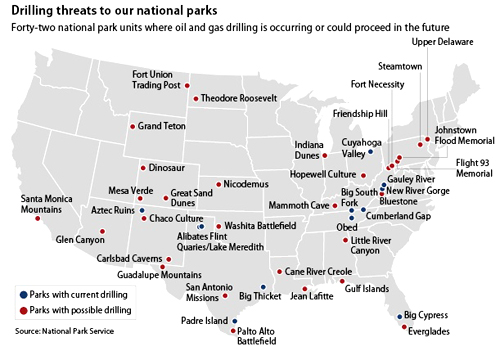

Center for American Progress
By Jessica Goad and Christy Goldfuss
America’s national parks are undoubtedly some of our “best ideas.” They are unique places across our country where public lands are preserved for their natural, cultural or historic value, as well as for the unique contributions they provide to local and regional economies and our national economic strength. This is why we have set aside national parks, national seashores, national memorials and other places managed by the National Park Service for future generations.
Even though we have protected these national park units to allow them to achieve their full environmental, cultural, historical and economic potential, threats to their preservation do arise. One of those threats today is the potential for future oil and gas development within national parks. We requested data from the National Park Service, which identified 42 park units where non-federal oil and gas drilling is or could be occurring in the future. Of these, 12 units currently have oil and gas operations within them, while 30 units may be threatened in the future with drilling. (see map below)
This data was compiled by the National Park Service by assessing three factors:
- The parks’ proximity to oil and gas resources
- Drilling activity already occurring near the parks’ boundaries
- The existence of non-federal mineral rights within the parks
These existing mineral rights are either inholdings—where an individual owns a piece of property completely surrounded by a park unit—or are non-federal subsurface mineral rights, which are frequently referred to as “split estate” where the federal government owns the surface of the land and a private entity owns the right to access the minerals below the ground. Private individuals or companies owned these mineral rights before the parks were created and have the legal right to access them.
Currently, any development activity on public lands, including national parks, must take place in accordance with various federal environmental laws to protect air, water, wildlife and public health. Additionally, operators must comply with National Park Service oil and gas regulations within park units.
But this time-tested process is now threatened by some politicians in Washington—influenced by the oil and gas industry—who propose to roll back or even completely eliminate federal oversight of energy on public lands in favor of more relaxed state regulations. This shift in management oversight of drilling in national parks would be more dangerous to maintaining the balance needed to develop our national parks to their full and varied potential, thereby placing the 42 areas highlighted above at an even greater risk.
Oil and gas drilling is a dirty business that, if done improperly, has the potential to do substantial harm to national parks and other public lands. Drilling involves not just the construction of rigs but also roads, pipelines, and other infrastructure. Toxic chemicals such as naphthalene and benzene are sometimes used in oil and gas drilling and production activities. There is also the equally real threat of spills, which are frequent both onshore and offshore. One estimate found that in North Dakota in 2011 alone there were more than a thousand spills of oil, wastewater or other drilling fluids.
The potential for future drilling within national parks is a real threat when seen through the lens of today’s political context. The American people deserve the right to have their say in the development of our national parks and public lands through their elected representatives in Washington. Rolling back federal regulations and having the states make these decisions would be exceedingly dangerous.
Visit EcoWatch’s FRACKING page for more related news on this topic.
——–
Jessica Goad is the Manager of Research and Outreach for the Center for American Progress’s Public Lands Project. Christy Goldfuss is the Public Lands Project Director at the Center.

 233k
233k  41k
41k  Subscribe
Subscribe 
